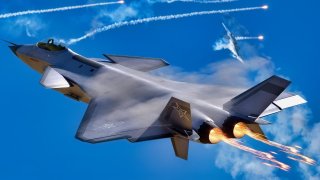Maya Carlin

China is upgrading its Chengdu J-20 fighter - This month, the Pentagon’s newly released China Military Power Report outlined how Beijing is experimenting with upgrades pertaining to its J-20 stealth fighter.
According to the report, the People’s Liberation Army Air Force is looking to introduce manned-unmanned teaming concepts to its newest fighter platform.
The U.S. Air Force implementing the same concept in its Next Generation Air Dominance fighter program.
Other upgrades being incorporated in China’s J-20 platform were also detailed in the report: “(China) is preparing upgrades for the J-20, which may include increasing the number of air-to-air missiles (AAM) the fighter can carry in its low-observable configuration, installing thrust-vectoring engine nozzles, and adding super cruise capability by installing higher-thrust indigenous WS-15 engines.”
As tensions continue to mount between Washington and Beijing, prospects for a future kinetic conflict are also increasing.
Introducing China’s J-20 Stealth Fighter
The Chengdu J-20 “Mighty Dragon”is China’s fifth-generation air-superiority fighter platform.
As a product of Beijing’s aerial modernization program, the J-20 is modeled after its American and Russian counterparts- the F-22, F-35 Joint Strike Fighter and Su-57.
The J-20 is notably the third-ever fifth-generation fighter jet to ever take to the skies.
In the 1990’s, the J-20 emerged from China’s J-XX program.
By 2016, the fighter made its public debut at the Zhuhai Air Show in Guangdong and is manufactured by the Sichuan-based Chengdu Aircraft Industry Group.
Specs and Capabilities
A direct competitor to American fifth-gen platforms, the J-20 possesses all the hallmarks of advanced stealth fighter.
From radar absorbent coating to an advanced suite of electronics and avionics to its sleek design, the J-20 is undoubtedly a formidable force.
In its short service tenure with the PLAAF, the Mighty Dragon has received a series of upgrades. In 2021, the Russian-designed AL-31FM2 engine that initially powered the Chinese jet was replaced with a homegrown WS10 engine.
While this engine is remarkably more capable than its Russian counterpart according to state-media, experts caution that the newer engine type has never been tested in battle and may be more of a paper tiger.
According to a principal defense analyst at Jane’s, “There are lingering questions over whether China has managed to achieve the thrust required on the J-20 on current payloads with the locally produced WS-10 engines.”
Additionally, another expert from the Yuan Wang military think tank in Beijing described the F-35’s XA100 engine as far superior to China’s WS-10.
What We Know about China’s Secretive J-20 Stealth Program
Based on the Pentagon’s recent report,analysts believe that the latest J-20 variant could also be under consideration for potential use for the control of unmanned aircraft. Specifically, experts believe that “wingman” drones could be piloted for the two-seat J-20 variation.
The U.S. Air Force is also approaching this new concept for its NGAD fighter. According to reports, the NGAD’s family of systems concept with incorporate unmanned aerial vehicles to fly alongside piloted fighter jets.
These Collaborative Combat Aircraft will function by carrying out surveillance, testing enemy air defenses and extend command and control through human direction. In this set up, the sixth-generation fighter will serve as the so-called quarterback for its accompanying unmanned drones.
Analysts estimate that China has manufactured somewhere between 180-220 J-20s so far, which is more than the 187 F-22 Raptors that were produced.
However, as pointed out by Air and Space Forces, serial markings displayed on airframes at air and trade shows indicate that Beijing may be painting deceptive serial markings on its jets to suggest a greater inventory than reality.
If war does break out between Washington and Beijing, the PLAAF’s arsenal of J-20 fighters would undoubtedly lead the way. Beijing is also further developing its H-20 stealth bomber program, which is believed to be a near-twin of the USAF’s own B-2 bomber.
No comments:
Post a Comment